Valley of Joy!
- Mahesh V
- Aug 19, 2018
- 11 min read
It was, as usual, a hot, sunny day in August. I was scheduling a call with a customer when I saw that August has a short week during Independence Day. Not an apt time to daydream, but I did. I thought...Aug 14 to 18: this week I should do something impulsive just like how I planned my Ujjain trip. I browsed few websites for ideas and then came across a trek to the Valley of Flowers. The itinerary looked interesting and just for the right amount of time I needed. I booked the trek, my flights and train. I was all set.
My itinerary was as follows
Day 1: Fly to Delhi. Take a train to Haridwar. Overnight at Haridwar
Day 2: Drive from Haridwar to Govindghat. Overnight at Govindghat
Day 3: Trek from Pulna to Ghangaria. Overnight at Ghangaria
Day 4: A day trek to Valley of flowers and back to Ghangaria. Overnight at Ghangaria.
Day 5: A day trek to Hemkund Sahib and back to Ghangaria. Overnight at Ghangaria.
Day 6: Trek back from Ghangaria to Govindghat. Evening visit Badrinath and Mana. . Overnight at Govindghat.
Day 7: Drive from Govindghat back to Hardiwar. Overnight at Haridwar.
Day 8: Train to Delhi and flight back home.
Day 1: Flight to Delhi and train to Hardiwar...
Aerial view of Lotus Temple, New Delhi
I reached Delhi around 9:30 AM. My train to Haridwar was at 3:30 PM. I had to kill my time in Delhi till then. I walked around a few places and finally camped in Agrasen ki Baoli. This is a historical stepwell near Connaught Place. The place had nice shade and windy enough to keep you cool. I didn't dare to step out as Delhi was burning. I patiently watched the young crowd joining me there - this place was not just popular among the pigeons but humans as well.

Agrasen ki Baoli: The view of the well and its chambers

Agrasen ki Baoli: The residents of the baoli :-)
At around 2:45 PM, I left for New Delhi Railway Station. The NDLS, as it is called, has 2 entrances. It makes sense to first check which entrance is closer to the platform your train arrives at the place is very chaotic and with lots of security checks. You need to scan your luggage at every entrance and exit so it is wise to use a rail app and know where the train is going to arrive or estimate based on where it arrived the previous day.
I enjoy train rides and looked forward to this train journey. It was a comfortable ride. I reached Haridwar at 7:30 PM that day. It was pouring that evening and we had to wait at the railway station. Haridwar is an ocean of people. People from all walks of life were part of the journey. The city had a vibrancy to it but the rain kind of dampened the enthusiasm. I took a cycle rickshaw and reached my hotel. I slept early that evening looking forward to the next day... the journey begins...
Day 2: Drive from Haridwar to Govindghat... errr which didnt happen
The journey began at around 8 AM. It was a rainy morning and apparently, that is what I was told to expect the entire journey till Govindghat. the route to Govindghat was very scenic. We drove along the Ganges and later Alaknanda. landslides were very common and we did encounter a lot of traffic and stoppages due to them. officials took their time in clearing the roads and for me, that time was to enjoy the local tea and Maggi. Maggi is a staple food along with tea and pakoras in some places.
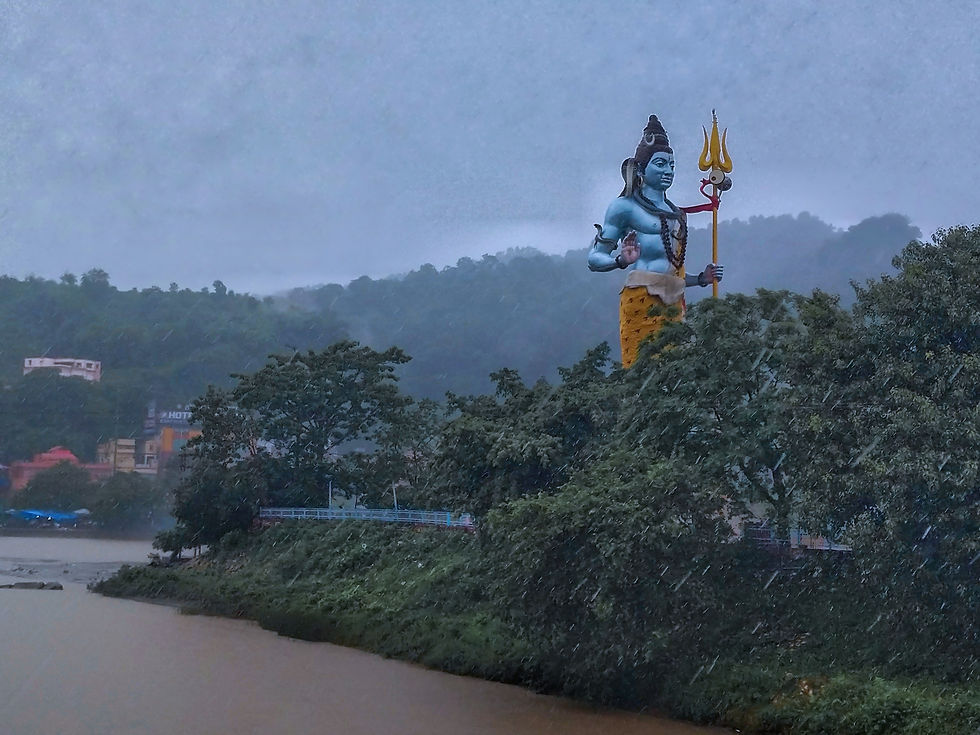
A huge Shiva statue in Haridwar

Landslides being cleared enroute

Blocked roads due to the landslides
I crossed Devaprayag on the way. This is the place where the river Alaknanda and Bhagirathi meet to form the river Ganges. One could distinctly see both the rivers joining each other and it was a mesmerising sight to watch. I wish I could spend more time there, but the unplanned stoppages on our way made us hurry.

Rudraprayag

Alaknanda - Bhagirathi Sangam
Not only the traffic added to the woes, but the vehicle also failed that evening and I ended up spending my night in Srinagar. A small town 170 km away from Govindghat. After resting for some time I started for Govindghat early morning 3:30 AM.

Drive to Govindghat
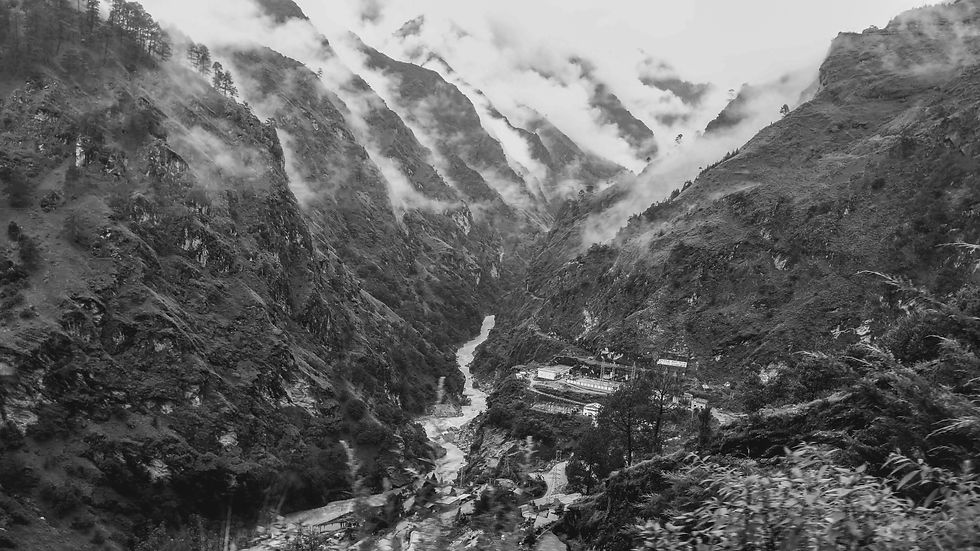
between mountains and mist

Alaknanda river being split by a mighty mountain
Day 3: Srinagar to Govindghat and Trek to Ghangaria
I reached Govindghat at 8:30 AM. Govindghat is a small town on the banks of Alaknanda river. The river speaks louder than any other living thing in that place. The rhythmically flowing Alaknanda has the power to soothe your mind. Govindghat is also the base town to start your trek to Valley of flowers, Hemkund Sahib and to drive to Badrinath and the border village of Mana.

Alaknanda river flowing besides govindghat

Govindghat town
After a quick breakfast, I drove to a small town named Pulna which is 5kms away from Govindghat. The trek began from there. The plan was to reach Ghangaria which will be my base for the next 2 days. The distance from Pulna to Ghangaria is 9kms. The trek takes approximately 4-5hrs depending on your stamina and agility. There are ponies/mules available to carry your backpacks and they charge approximately 1000rs per pony/mule. Each pony can carry up to 4 backpacks so the cost can be shared between the trekkers. The pony can also transport people. So if you want to reach Ghangaria quickly, this is one of the options.

Ponies are used to carry people and trekking bags
The other option is to avail a helicopter service from Govindghat to Ghangaria. The onward service starts at around 6AM and is continued till 2PM subject to weather conditions. The return service starts at around the same time and continues till evening. The total distance from Govindghat to Ghangaria is around 14kms which are done under 10min using the helicopter.
The Trek.. one of the best experiences...
I started my ascent at around 11 AM. Slowly and steadily. The route traces the path of Alaknanda and it involves crossing the river a couple of times. Alaknanda rapids were quite heavy and all the noise around you was camouflaged by it. The path itself was stepped and you need to be mindful of the ponies that keep crossing you time and again. Specific instructions were given to us to stick to the mountainous side of the path and not on the valley side.

The trekking route

Alaknanda River - the water source is the melting ice from the himalayas
YouTube video: Flow of River Alaknanda
There are multiple shops on the way serving all types of food items. Unless you have a specific choice of food, there's no need to pack food and carry with you (thereby also reduce the weight).

shops on the way
I reached Ghangaria around 8 PM. Ghangaria is a very small settlement which operates for 4-5 months during the year. These 4-5 months are the best time for them to earn their living. There are lots of lodges and shops for people to stay and eat. Warning: Don't expect a high standard of hygiene and taste. Once you keep that level of expectations, you'll like the place for what it is. There's a small gurudwara in Ghangaria and one can also choose to the langar food there.
Day 4: Trek to Valley of Flowers
The next we started our trek to the Valley of Flowers at around 7:30 AM. The distance to the valley from Ghangaria is approximately 4kms one way. This trek has a well laid out path and there are steps all the way up to the valley. However, these steps are built using broken pieces of rock and are uneven. The path itself is very narrow and the climb is steep and intense. It does become alright as one nears the valley.

the trek to the Valley of flowers starts at Ghangaria

June to mid-September is the season for the valley of flowers trek and it did show there when we saw the crowd. there are porters who actually carry people to the valley on their back. It does give you a sense of realisation of the kind of life people lead around you. The porters can do 1-2 such trips in a day. I was amazed at their grit and courage to do this every day. They carry bags and people weighing anywhere from 20-80kgs on their back. The bag has warm cushioning and rain protection. The porters are available at the entry gate to the valley of flowers.

a long slow walk to the valley - August being one of the peak months for tourism

broken pieces of rock make the pathway to the valley...

peek-a-boo between the clouds and the valley

at the valley of flowers
pics from the valley

I started my descend around 1:30 PM and reached Ghangaria back at around 5 PM. The evening was spent walking around the place and trying local food. Would definitely recommend you to try the local jalebis and gulab jamun.
Day 5: Trek to Hemkund Sahib
As like yesterday, I started the trek at around 7:30 AM. Unlike Valley of flowers, this trek can be done on Ponies. This is a longer but more comfortable trek. Hemkunt is a Sikh Gurudwara and a well-known pilgrimage site. The gurudwara is dedicated to Guru Gobind Singh Ji and located at approximately 15,000 feet above sea level. The total distance from Ghangaria village to Hemkund Sahib is 6.5kms one way. The path is stepped and well laid. The Gurudwara is closed after October due to snow. The pilgrimage begins in July, but from May onwards the Sikh pilgrims come back to repair the path damaged due to snow and make it safe for the pilgrims. This is a social work involuntarily pursued and considered as a selfless service. There are shops and water streams to fill your stomach and quench your thirst.
The last 1km to Hemkunt can be covered via two routes. One is a normal circular route that resembles the earlier path and one can continue with that. The other is a very steep climb of close to 1,000 steps which is slightly faster than the normal path. Both can be opted to reach Hemkunt depending on the visitor's ability. The ponies don't take the steep step path. They follow the regular path.

path enroute to Hemkunt

thirsty ponies...

the path to Hemkunt

inside the gurudwara

langar food being served

lake in hemkunt

a sikh volunteer guarding the lake

a volunteer helping in cleaning the utensils
After spending some time at the Gurudwara, I slowly started my walk back to the base - Ghangaria. I started at around 1:30 PM and reached Ghangaria back by 5:30 PM. It was one of the most memorable treks. Trek to Valley of flowers and Hemkunt is classified as easy trek - but what it means is that it is easier compared to other treks in the Himalayas. But the trek is very challenging in nature and does need a lot of preparation of its own.
Day 6: Trek back to Govindghat
This was the day when I had to head back to Govindghat. The idea was to start early so that we get an extra half a day to visit Badrinath and Mana village. I started at 7:30 AM and reached Govindghat by 12:30 PM. As a result, I had sufficient time to cover Badrinath and Mana.
Badrinath
Badrinath is an important pilgrimage site for Hindu devotees. The town gets its name from Badrinath temple which is one of the 4 abodes that one must visit. The others being Rameshwaram, Dwarka, and Puri. The temple is located along the banks of Alaknanda river at a height of 10,000 feet above sea level. Compared to Kedarnath, this is one of the easier places to visit and the temple is accessible entirely by road.

Badrinath Temple

Narayana parbath located behind Badrinath Temple

Inside the temple premises

devotees singing inside the temple
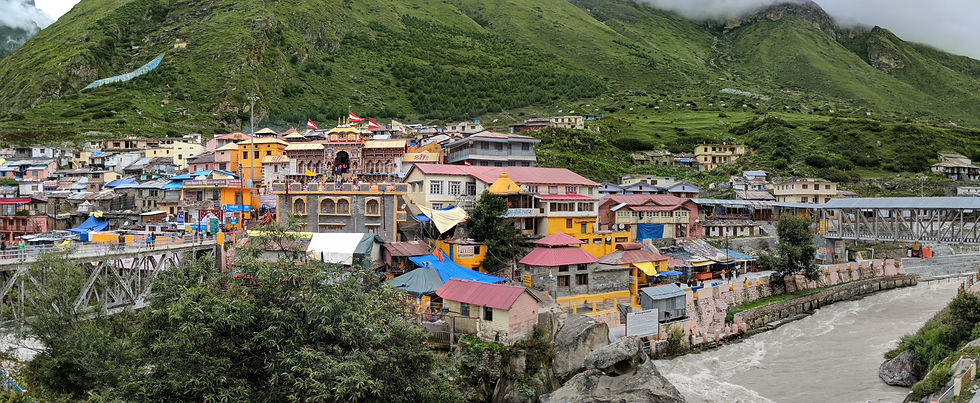
Badrinath temple with Narayana Parbath and Alaknanda river
Mana Village
Mana is a small Indian village bordering Tibet. This is the last village in Uttrakhand state. This village is accessible by road. Tibet is around 30kms from this village and is accessible via Mana Pass which is the highest motorable road in the world.
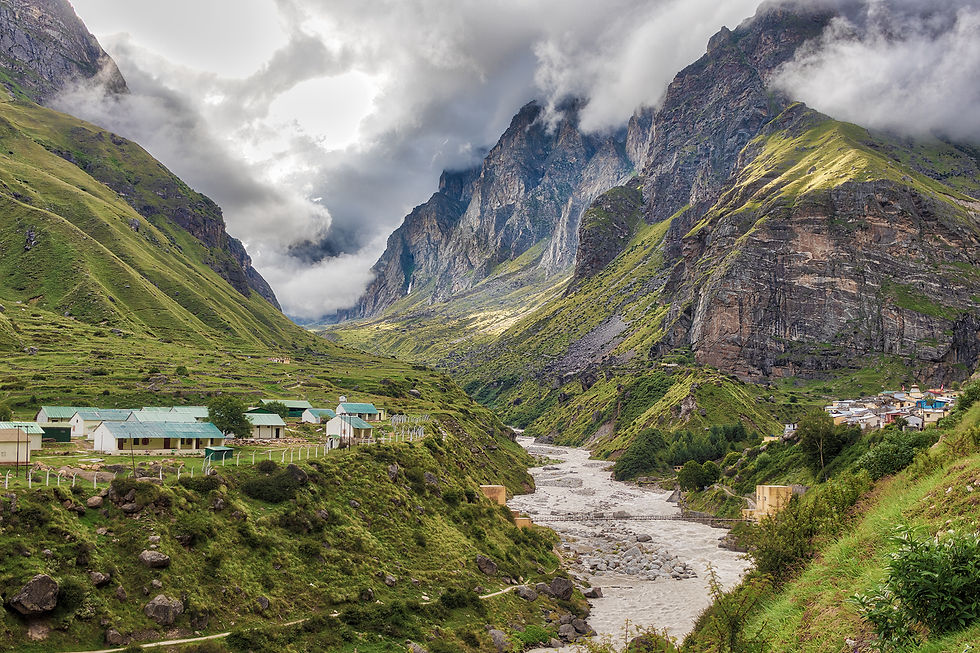
Mana Village on the right side (corner). Indian army camp on the left

Entrance to Mana
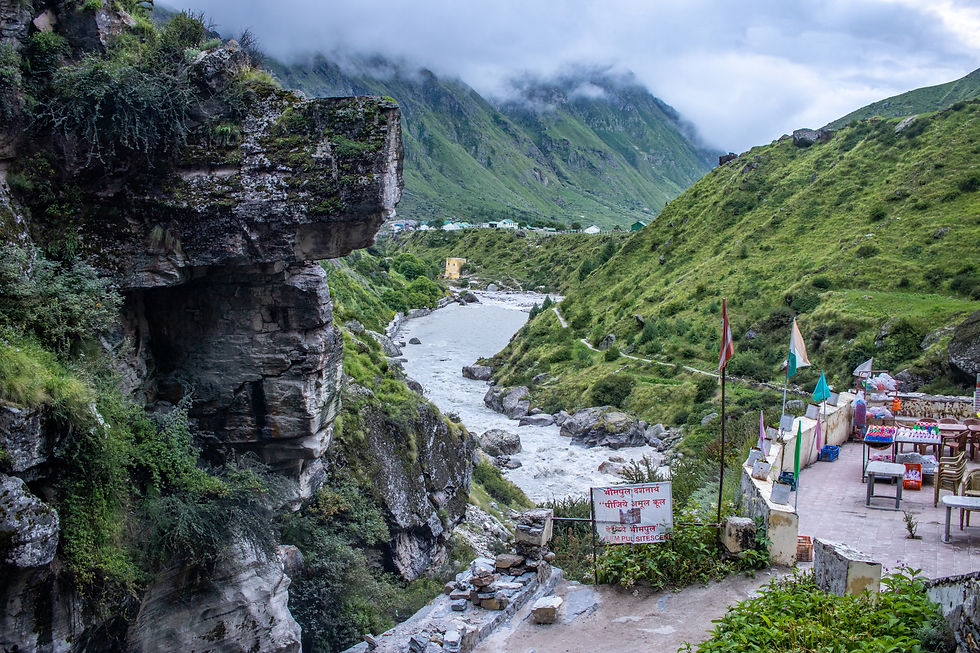
View from Mana

Bheema Pul
Bheema Pul is associated with the mythological story of Mahabharatha. Bheema placed this rock for the Pandavas to cross the River Saraswati and continue their journey towards heaven.
Apart from this, there are other points of interest such as Vyas Gufa (Vyas Cave) where apparently Vyas recited the Mahabharata. Vyasa Gufa rock has multiple carvings that resemble lines. The local legend is that it is actually the book of Mahabharatha (Vyasa Pothi) which is closed and kept and these lines are actually the pages of the book. Just near the Vyasa Gufa is Ganesh Gufa (Ganesha's Cave) where Lord Ganesh sat to write the Mahabharata.

There are multiple shops here which claim to be the last tea shop in India. Guess, it is one way of marketing themselves. The locals are very friendly and humble. They make their living by knitting sweaters and shawls. They also grow local tea powder and spices that can be used for cooking. I would recommend to buy a couple of things from them and support them as the living conditions are pretty ordinary.
Day 7: Drive back to Hardiwar
After an overnight stay in Govindghat, I started for Hardiwar to end my trip. If one starts early, they can be on time to witness the Ganga aarti in Hardiwar. It is an awesome spectacle and must not be missed. The last aarti is at 7PM and goes for 30 mins.

River Ganga in Hardiwar

view from Bhagirathi Sethu (Bridge)
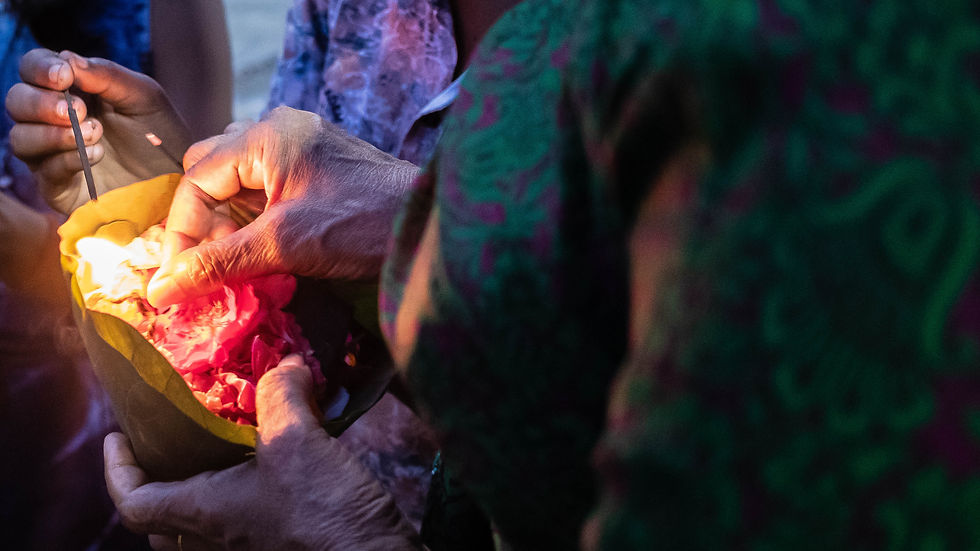
believers performing the final puja of the day in Ganga

A busy Haridwar street

The local market may not be such a delight to walk especially after rains. However, on a nice dry day, you should try exploring the local eating joints. Haridwar is a veg only location hence you will find a range of vegetarian options and cuisine. After a short stroll in the market and trying some local delicacies I headed back to my room. I left the city the next morning.
Some trekking tips for beginners like me
A 60L backpack is more than enough for this trek. Carry another 20L backpack for day trips to Valley of flowers and Hemkunt
Watch the preparation videos shared by experienced trip organizers such as Indiahikes to understand how to pack your bags and what to carry. There are multiple other videos by them and others on YouTube
Buy a good trekking shoe with ankle support and waterproofing. I own a Trek 100 show and it saved my ankle from twisting multiple times during the trek
Carry a water bottle. During the trek, there are streams from which you can directly drink water. If you don't want to carry a bottle, carry a cup/glass with you to drink water at the stream
Trekking poles help you during the walk. If you don't want to invest in a pole, at the trek you will find a lot of shops selling strong bamboo sticks which can also be used as poles. They are very useful especially when getting down
There's a restaurant named Khalsa in Ghangaria. Would recommend that as they have decent options and I loved the taste
Some travellers have faced altitude sickness while trekking to Hemkunt Sahib. I (and the people who trekked with me) did not face it. Any altitude sickness tablet needs to be had 3 days before the trek. There's no point in having it the morning before the trek starts. Pls consult a doctor before consumption of such tablets
Support the locals. Try buying from the locals wherever possible so that they prosper and stay motivated to earn their living
Hiring a pony from Govinghat to Ghangaria & back from Ghangaria to Govindghat is a wise option
Water bottles become expensive as one goes higher. So buy bottles from the lowest base if needed and use that till the end of the trip
Last point - Please take care of your surroundings. You will hear this multiple times when you see some of the trekking YouTube videos. Try not to dump plastic and other non-degradable waste irresponsibly as it harms the habitat
Signing off for now --- Happy Trekking!



















































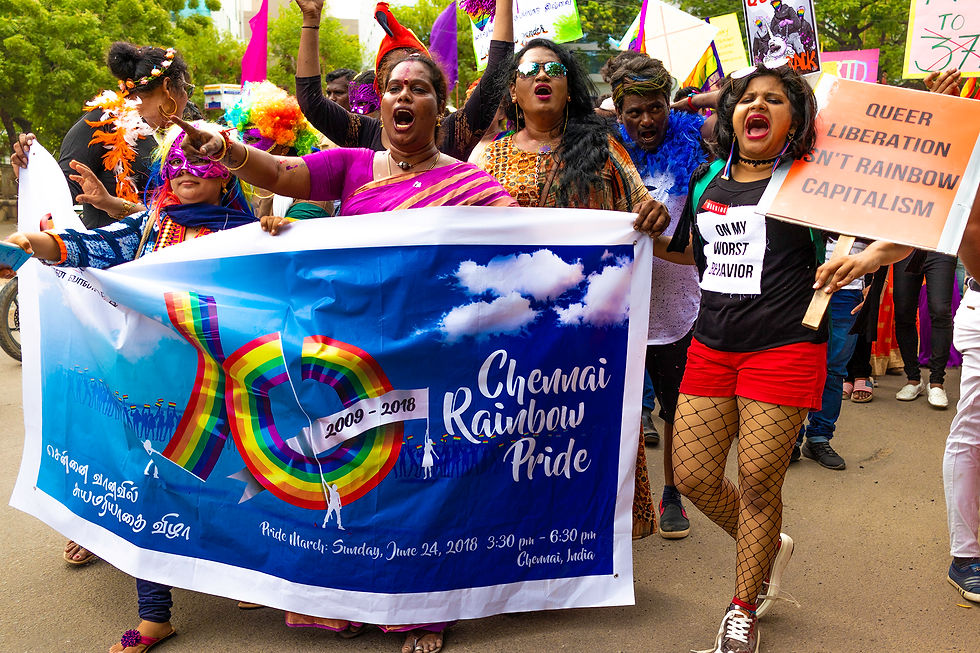
Comments